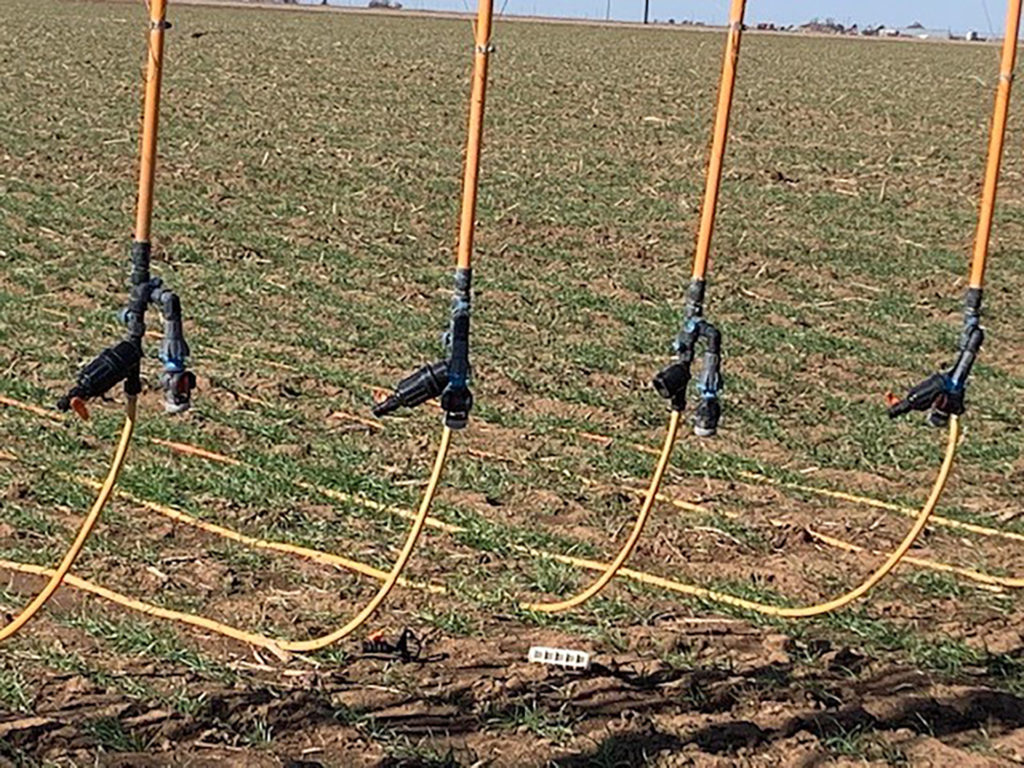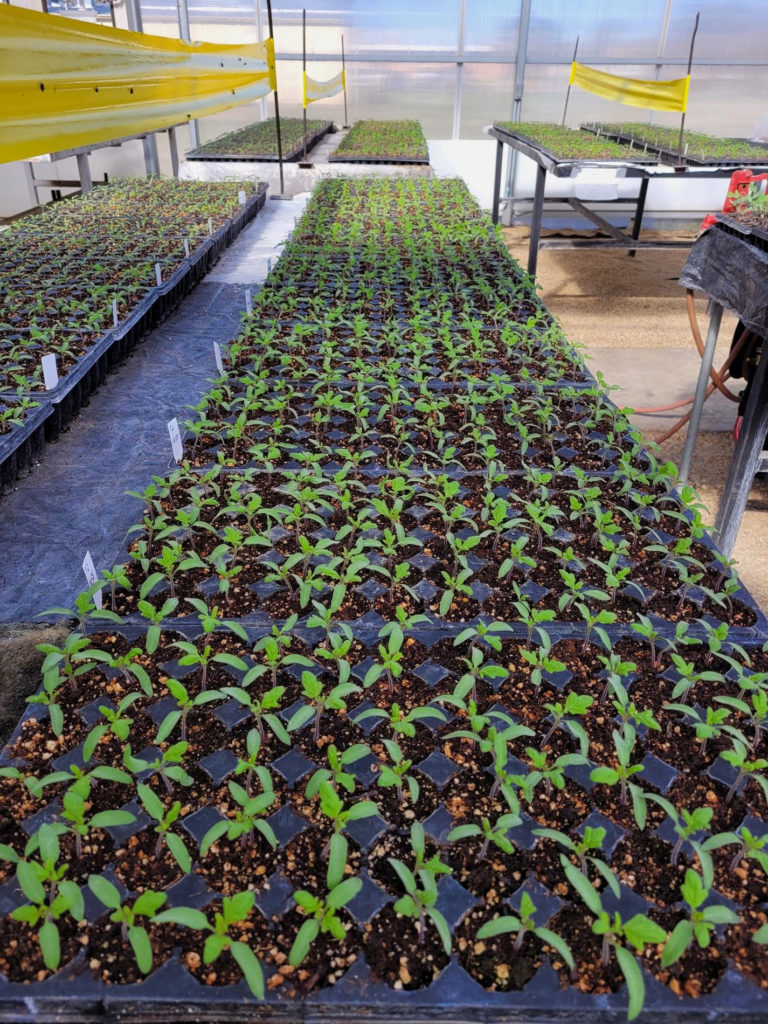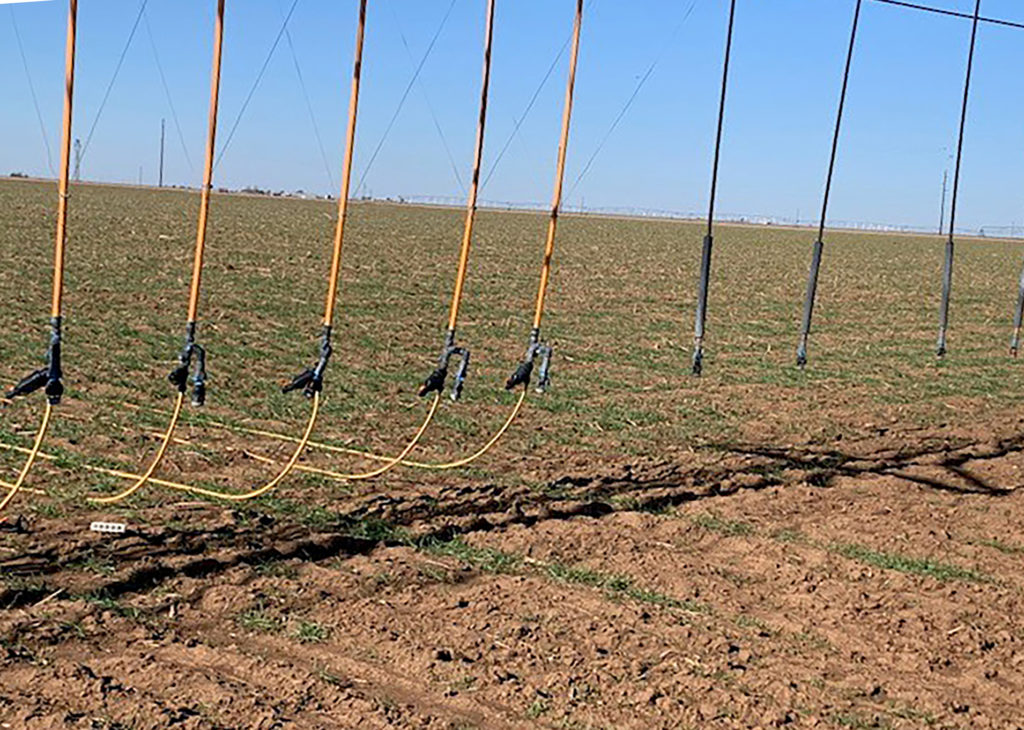Specialty crops potential: More return for water, utilize center pivots
Texas A&M AgriLife study to track irrigation methods, timing on tomatoes
Agriculture producers in the Texas High Plains could potentially diversify their operations by growing specialty crops and get higher returns for their water – without having to replace their irrigation systems.

With a declining water table in mind, Texas A&M AgriLife, U.S. Department of Agriculture-Agricultural Research Service and three industry partners will investigate the potential of producing high quality vegetables under irrigation for fresh market sales.
The research will include the use of mobile drip irrigation, MDI, integrated with a patented, computerized irrigation scheduling system that uses plant and soil water sensing and weather feedback. The system is called Irrigation Scheduling and Supervisory Control and Data Acquisition, or ISSCADA.
Charlie Rush, Ph.D., Texas A&M AgriLife Research plant pathologist, Amarillo, has been evaluating melons, peppers and tomatoes for AgriLife Research’s breeding program in the High Plains climate for many years. His interest spiked when he started working in high tunnels, and he has compared production inside and outside the tunnels for produce quality in the different climates.
The focus of Rush’s latest study is on types of irrigation and irrigation scheduling. The study is funded by a grant from the Irrigation Innovation Consortium at Colorado State University. The Consortium is funded by a $5 million, five-year grant from the Foundation for Food and Agriculture Research.
More production, profit per drop of water
Approximately 4.5 million acres of cropland are irrigated by over 30,000 center pivot systems in the Texas High Plains. Most of these irrigated acres are planted to corn and cotton. However, due to declining groundwater and increasing pumping costs, growers are continually searching for economic alternatives to those commodity crops. Among those alternatives may be high value specialty crops, such as watermelon, cantaloupe, tomatoes and peppers.
“It’s fairly well recognized that where people are commercially growing high quality, fresh-market tomatoes outside, they are doing so with drip (irrigation),” Rush said. “So, if we want people in the Texas Panhandle to grow high value crops, they need to do it with drip irrigation. However, our farmers have already invested in center pivot systems. So, how do you grow higher value produce when everyone has a pivot and we know drip irrigation does best? That’s where we will focus this study.”
The first step included retrofitting portions of a center pivot system at the research facilities near Bushland. The spray nozzle that typically hangs from center pivots were replaced with a tube that has holes in the dripline that will drag across the field as the pivot moves. Additionally, traditional driplines will be a part of the test.

“We know there is a local market for tomatoes, so that is where we are starting,” Rush said. “People like getting that fresh tomato, and we have access to markets and experience growing them. But in this study, we are looking at irrigation aspects that will be applicable to other specialty crops as well.”
Rush said the team has planted tomatoes from seed in the greenhouse. The resulting 2,500 plants will be transplanted into the field around May 1, depending on the weather. The plants will be irrigated with a sprinkler or the mobile drip, as well as with the surface dripline. The researchers will compare how the different methods impact water use, water-use efficiency, plant growth and development, root dynamics, and pest and disease development.
Qingwu Xue, Ph.D., AgriLife Research plant physiologist, Amarillo, will quantify how the plants respond to abiotic stresses, and Rush will take the lead on detecting and quantifying biotic stresses.
When the tomatoes are harvested, Justin Benavidez, Ph.D., Texas A&M AgriLife Extension Service economist, Amarillo, will do the economic analysis.
“We’ll use what we harvest and sell for projections on what it would give producers on a per-acre basis,” Rush said.
When, where and how much to irrigate
The project will also examine in detail when, where and how much irrigation is best where specialty crops are concerned.
“It’s one thing to compare delivery systems, but it doesn’t tell you anything about how much water you should be putting out with the different systems,” Rush said.

To help answer these questions for growers, the team members and industry collaborators developed the ISSCADA system. The system consists of a wireless network of canopy temperature sensors mounted on the pivot, soil water sensors strategically placed in the field, and an automated weather station, all integrated with variable rate irrigation, VRI, on a center pivot sprinkler.
The system monitors plant and soil water status and provides users with automated, site-specific watering recommendations in the form of prescription maps that can be fed to the center pivot control panel. MDI, integrated with ISSCADA to optimize irrigation scheduling, will be compared with conventional center pivot irrigation with low elevation sprinkler application and traditional surface drip, with regard to crop yield, quality, water use, water-use efficiency and total economic return.
Placing the sensors and operating the ISSCADA system will be the responsibility of Susan O’Shaughnessy, Ph.D., USDA-ARS research agricultural engineer with the Soil and Water Management Research Unit, Bushland. She will direct the scheduling of irrigation treatments, and work collaboratively with Paul Colaizzi, Ph.D., also a USDA-ARS research agricultural engineer with the Soil and Water Management Research Unit, Bushland.
Colaizzi, whose primary interests are the energy and water balances of irrigated crops, will be responsible for quantifying plant/soil water relations in the three irrigation systems.
Specialty equipment to capture the data
The team will employ an MDI system designed by Monty Teeter, president of Dragon Line, an industry collaborator. This Dragon Line system allows for individual sprinkler sections to apply water independently. Dragon Line has also designed and installed the driplines to ensure they travel over the plant bed.
Jake LaRue, irrigation consultant with Valmont Industries, Owasso, Oklahoma, has helped with the installation of the MDI system at Bushland and helped the team address cultural practices and challenges that other vegetable growers using sprinkler irrigation systems have encountered.
Engineering and technical support for laying out the wireless infrared thermometer sensor network system on the center pivot has been provided by Mike van Bavel, president of Dynamax Inc.
With the sensors installed and the irrigation systems retrofitted, the team is set to measure soil water status throughout the 2021 and 2022 growing seasons.
“Susan and Paul have been doing this work on modeling soil and plant water relationships for a long time and working with irrigation scheduling systems, variable rate site-specific irrigation – so combining that with our agronomics makes a great team,” Rush said.
“The ultimate focus is how to best grow tomatoes to get the highest quality and highest yield with the best water conservation.”


